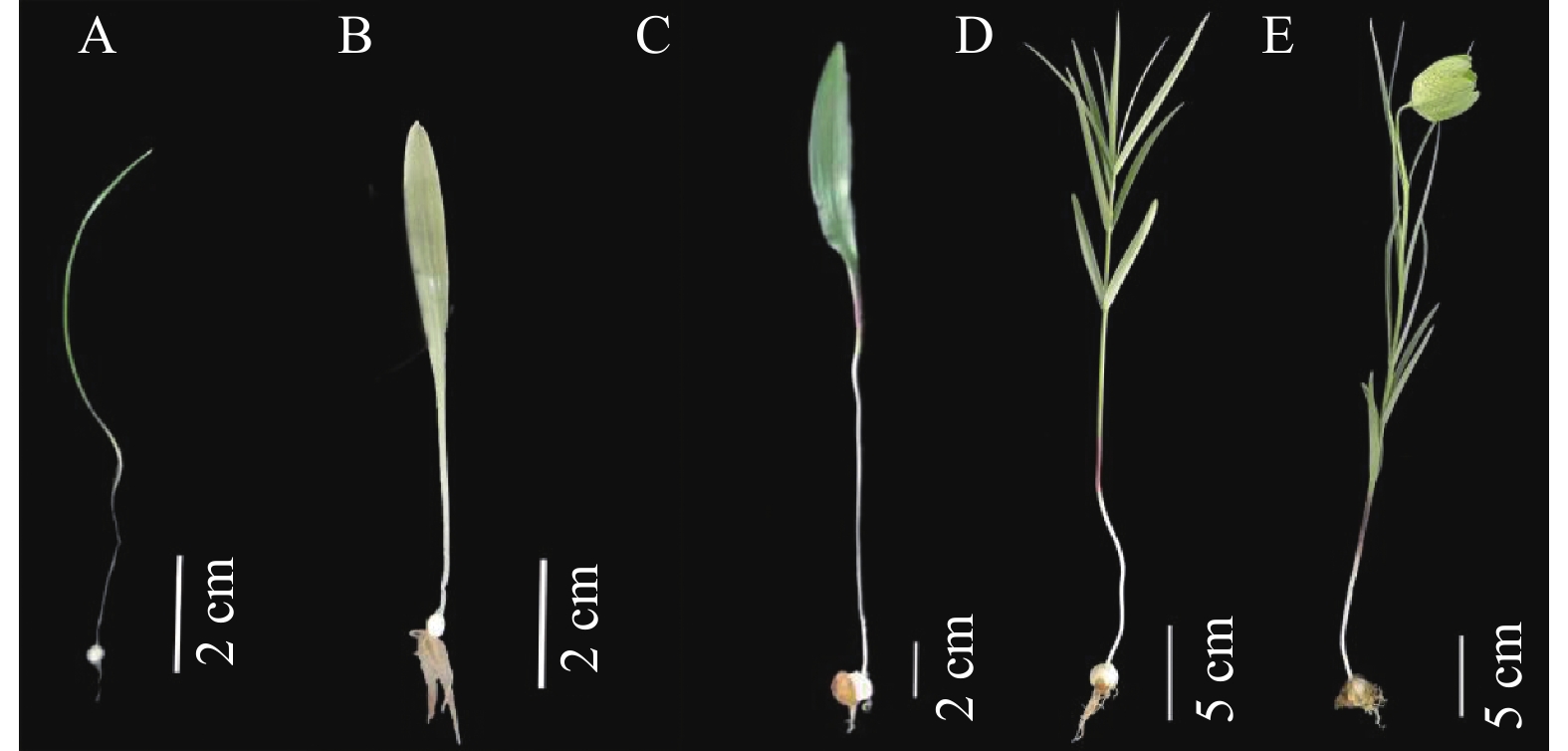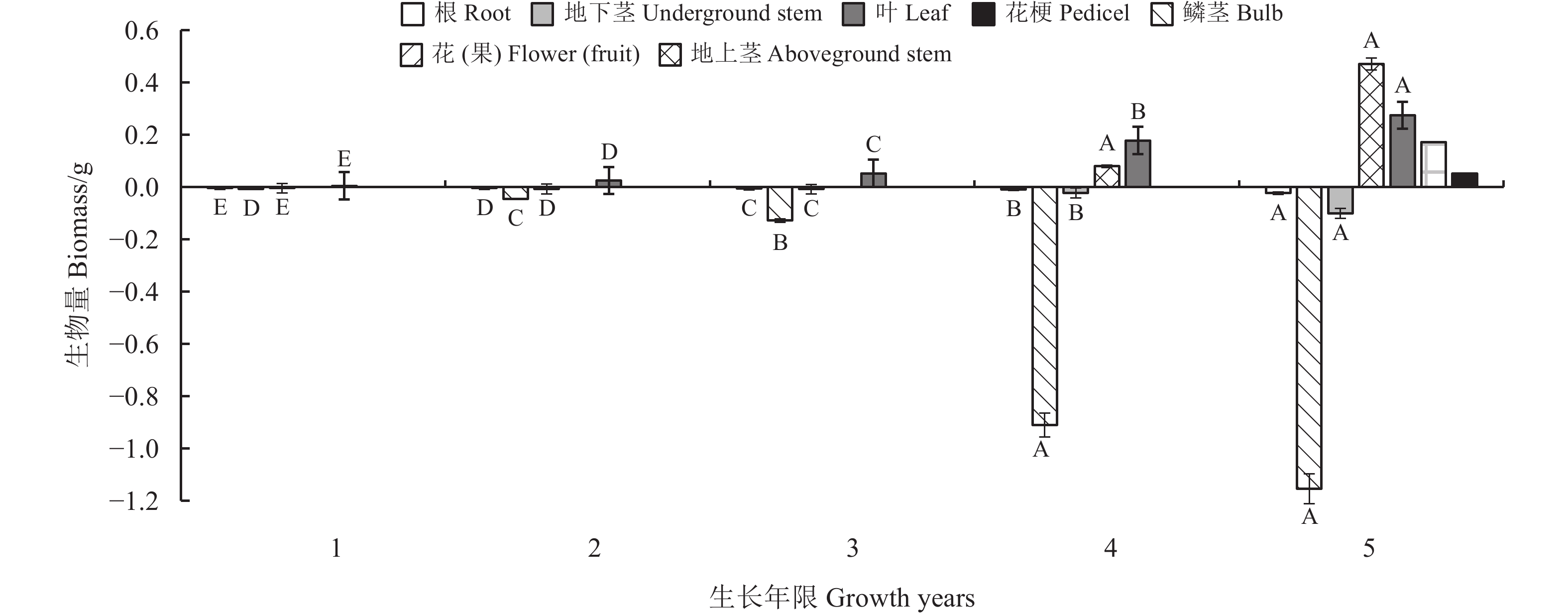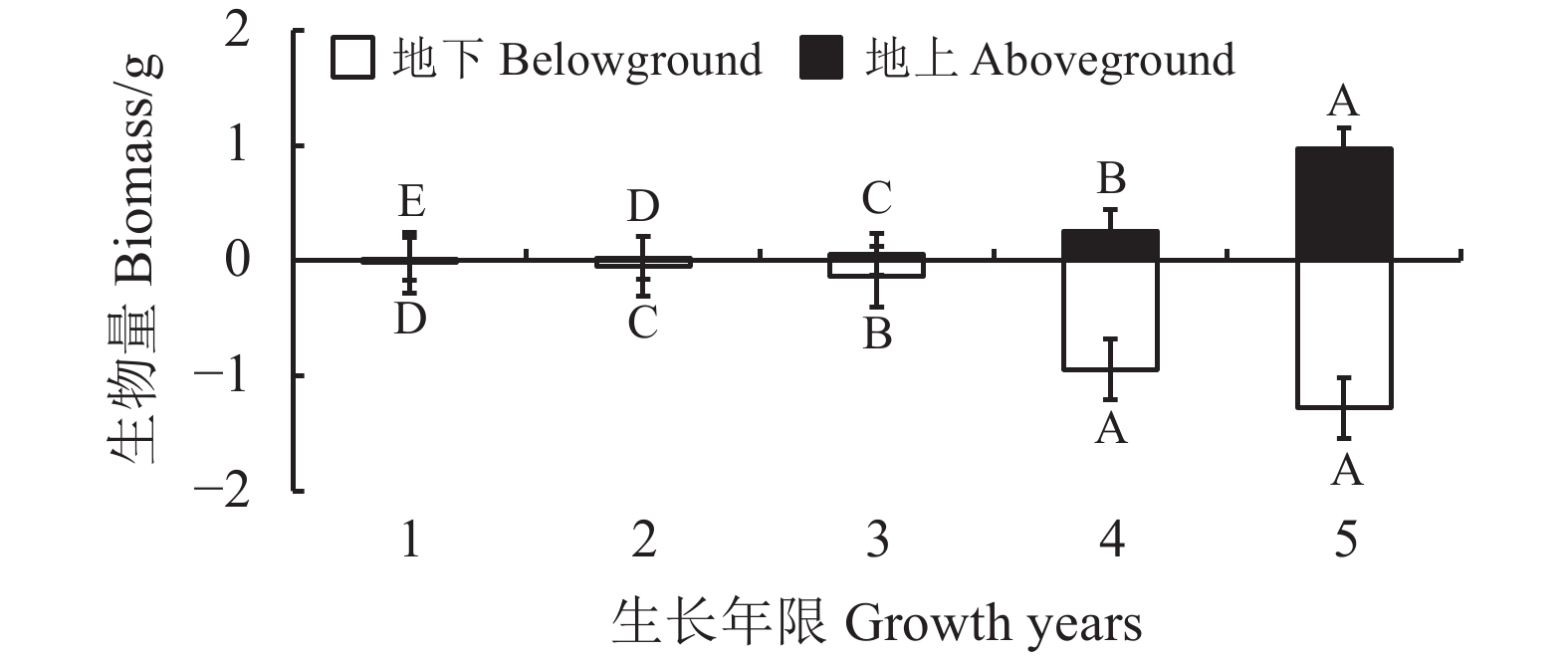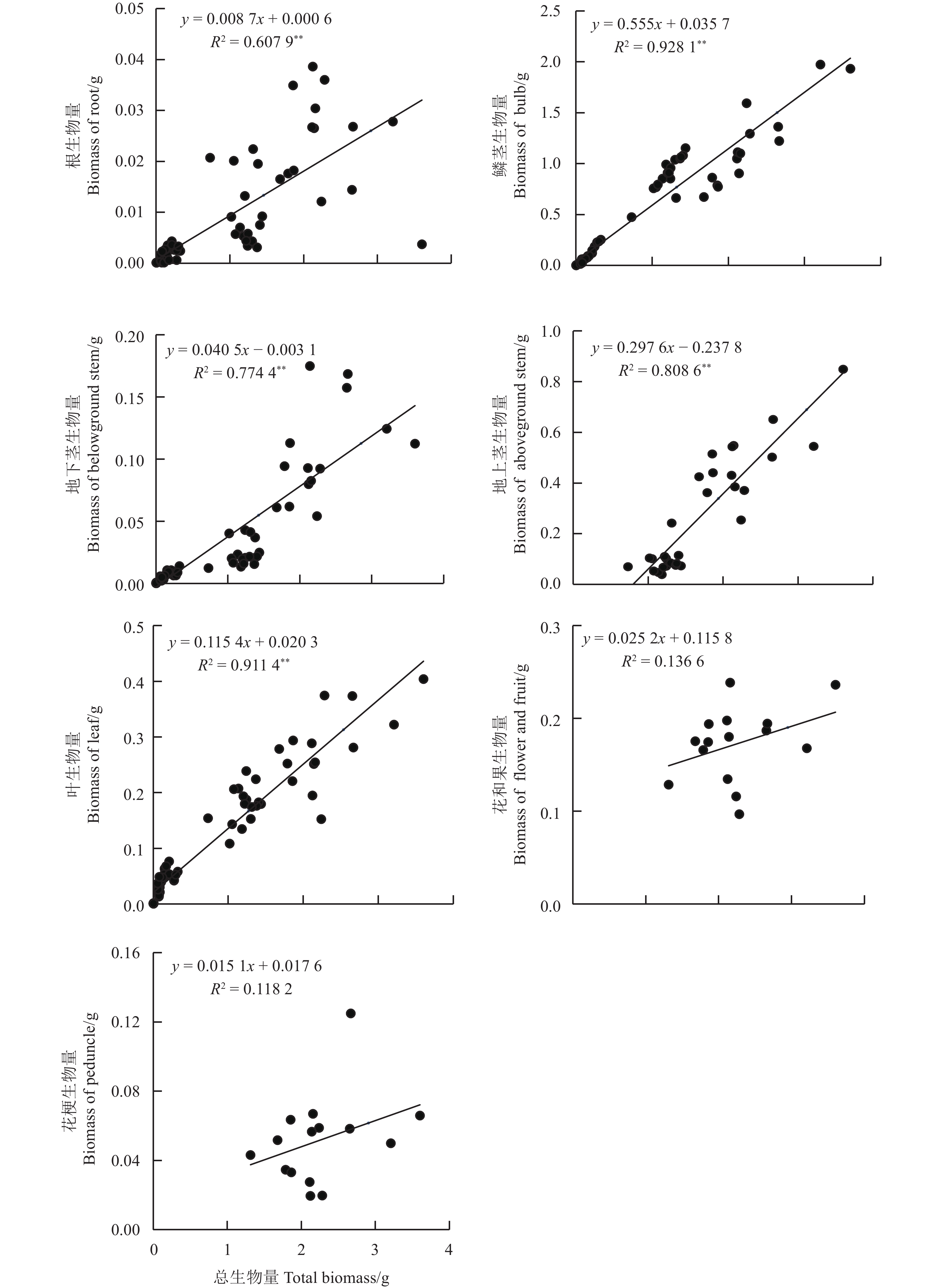不同年限川贝母生物量及异速生长
对不同年限的川贝母(Fritillaria cirrhosa)各器官称重,比较不同栽培年限川贝母的各器官性状及生物量占比,并进行正态性检验和方差分析,利用标准化主轴回归分析探明川贝母的生物量积累及其异速生长规律。结果表明,不同年限川贝母各器官生物量大小表现为鳞茎 > 叶 > 地下茎 > 根;川贝母鳞茎及叶片生物量在第4年增长最多,根系及地下茎生物量在第5年增长最多;川贝母地上部分与地下部分生物量均随生长年限的增长而不断增大,且地上部分各器官生物量间均差异显著(P < 0.05)。整个生长过程中,川贝母各器官生物量占总生物量的比例随年限增长而有所变化,且各器官生物量与总生物量之间均正相关。除生长第5年川贝母花和果的生物量与总生物量为等速生长模式外,其余年限川贝母各器官生物量与总生物量皆为异速生长模式,为人工生产川贝母提供理论依据。
English
-
参考文献
[1] 马艳珠, 崔治家, 张小荣, 邵晶, 晋玲, 马毅, 王振恒, 刘立, 曹小洪, 雷有庭. 中药川贝母资源学与商品鉴别研究进展. 世界中医药, 2022, 17(13): 1944-1950. doi: 10.3969/j.issn.1673-7202.2022.13.024 MA Y Z, CUI Z J, ZHANG X R, SHAO J, JIN L, MA Y, WANG Z H, LIU L, CAO X H, LEI Y T. Resources and identification of bulbus Fritillariae cirrhosae: A review. World Chinese Medicine, 2022, 17(13): 1944-1950. doi: 10.3969/j.issn.1673-7202.2022.13.024
[2] 熊浩荣, 马朝旭, 国慧, 杨振安, 赵川, 杨刚. 川贝母野生基原植物资源分布和保育研究进展. 中草药, 2020, 51(9): 2573-2579. XIONG H R, MA C X, GUO H, YANG Z A, ZHAO C, YANG G. Research progress on wild source plant resources distribution and conservation of Fritillariae cirrhosae bulbus. Chinese Traditional and Herbal Drugs, 2020, 51(9): 2573-2579.
[3] CUNNINGHAM A B, BRINCKMANN J A, PEI S J, LUO P, SCHIPPMANN U, LONG X, BI Y F. High altitude species, high profits: Can the trade in wild harvested Fritillaria cirrhosa (Liliaceae) be sustained? Journal of Ethnopharmacology, 2018, 15(223): 142-151.
[4] 中华人民共和国国家林业局, 中华人民共和国农业部. 国家重点保护野生植物名录: 2021年15号令. The State Forestry Administration, The Ministry of Agriculture. The National Key Protected Wild Plants List: 15, 2021.
[5] NIKLAS K J. Modelling below-and above-ground biomass for non-woody and woody plants. Annals of Botany, 2005, 95(2): 315-321. doi: 10.1093/aob/mci028
[6] 程栋梁, 钟全林, 林茂兹, 金美芳, 钱瑞芳. 植物代谢速率与个体生物量关系研究进展. 生态学报, 2011, 31(8): 2312-2320. CHNEG D L, ZHONG Q L, LIN M Z, JIN M F, QIAN R F. The advance of allometric studies on plant metabolic rates and biomass. Acta Ecologica Sinica, 2011, 31(8): 2312-2320.
[7] 李春萍, 李刚, 肖春旺. 异速生长关系在陆地生态系统生物量估测中的应用. 世界科技研究与发展, 2007, 29(2): 51-57. LI C P, LI G, XIAO C W. The application of a llom etric relationships in biomass estimation in terrestria ecosystems. World Sci-tech R & D, 2007, 29(2): 51-57.
[8] 颜廷雨, 成思丽, 胡兆柳, 徐德兵, 蔡年辉, 黄键. 外源赤霉素对去顶后云南松生物量分配的影响及异速生长分析. 林业科技通讯, 2023(2): 19-24. doi: 10.13456/j.cnki.lykt.2022.09.29.0001 YAN T Y, CHENG S L, HU Z L, XU D B, CAI N H, HUANG J. Effects of exogenous gibberellin on biomass allocation and allometry of Pinus yunnanensis after topdressing. Forest Science and Technology, 2023(2): 19-24. doi: 10.13456/j.cnki.lykt.2022.09.29.0001
[9] 张力斌, 何明珠, 张珂. 柠条锦鸡儿生物量分配规律与异速生长对氮、磷添加的响应. 生态学报, 2023, 43(16): 1-10. ZHANG L B, HE M Z, ZHANG K. Response of biomass allocation and allometric growth of Caragana korshinskii to nitrogen and phosphorus addition. Acta Ecologica Sinica, 2023, 43(16): 1-10.
[10] 应益山, 杨丽婷, 程建新, 兰春宝, 陈双林, 郭子武. 不同生境对苦竹鞭根形态结构及其异速生长的影响. 西北植物学报, 2022, 42(9): 1583-1590. YING Y S, YANG L T, CHENG J X, LAN C B, CHEN S L, GUO Z W. Effect of habitats on the morphological and structural characteristic of rhizome roots of Pleioblastus amarus and Its allometric growth. Acta Botanica Boreali-Occidentalia Sinica, 2022, 42(9): 1583-1590.
[11] 马莉, 符德欢, 苏钛, 王丽, 蒲星宇, 李双良. 不同海拔滇重楼生物量分配及异速生长分析. 时珍国医国药, 2023, 34(3): 697-701. MA L, FU D H, SU T, WANG L, PU X Y, LI S L. Biomass allocation and allometry of Paris polyphylla var. yunnanensis with different altitudes. Lishizhen Medicine and Materia Medica Research, 2023, 34(3): 697-701.
[12] 柳佳莹, 黄丽婷, 郑俊鸣, 荣俊冬, 陈礼光, 李士坤, 郑郁善. 毛竹不同器官化学计量的年龄动态特征及异速生长. 东北林业大学学报, 2022, 50(9): 23-28. doi: 10.13759/j.cnki.dlxb.2022.09.008 LIU J Y, HUANG L T, ZHENG J M, RONG J D, CHEN L G, LI S K, ZHENG Y S. Dynamic age characteristics and allometric growth of different organ soiichiometry in Phyllostachys edulis. Journal of North-East Forestry University, 2022, 50(9): 23-28. doi: 10.13759/j.cnki.dlxb.2022.09.008
[13] 石义强, 玉米提·哈力克, 艾买尔·吾斯曼. 不同生长阶段胡杨冠层垂直结构叶性状差异及异速生长关系. 东北林业大学学报, 2023, 51(6): 6-12. SHI Y Q, Ümüti·Halike, Wumaier·Wusiman. Differences in leaf traits and allometric growth relationships in the vertical structure of Populus euphratica at different growth stages. Journal of North-East Forestry University, 2023, 51(6): 6-12.
[14] 王元忠, 张霁, 沈涛, 张金渝. 不同生长年限滇重楼的生物量分配与异速生长研究. 中草药, 2022, 53(11): 3456-3462. WANG Y Z, ZHANG J, SHEN T, ZHANG J Y. Biomass allocation and allometry of Paris polyphylla var. yunnanensis with different ages. Chinese Traditional and Herbal Drugs, 2022, 53(11): 3456-3462.
[15] 陈国鹏, 杨克彤, 王立, 曹秀文, 陈林生. 甘肃南部7种高寒杜鹃生物量分配的异速生长关系. 植物生态学报, 2020, 44(10): 1040-1049. doi: 10.17521/cjpe.2020.0119 CHEN G P, YANG K T, WANG L, CAO X W, CHEN L S. Allometric relations for biomass partitioning of seven alpine Phododendron species in south of Gansu. Chinese Journal of Plant Ecology, 2020, 44(10): 1040-1049. doi: 10.17521/cjpe.2020.0119
[16] 张世航, 龚莉, 戈玉莹, 洪志, 江浩然, 刘纪元, 陶冶. 不同密度下入侵植物北美车前生物量分配与异速生长关系. 草业科学, 2021, 38(10): 1938-1949. doi: 10.11829/j.issn.1001-0629.2021-0150 ZHANG S H, GONG L, GE Y Y, HONG Z, JIANG H R, LIU J Y, TAO Y. Biomass allocation and allometric relationships of the invasive plant species Plantago virginica grown at different densities. Pratacultural Science, 2021, 38(10): 1938-1949. doi: 10.11829/j.issn.1001-0629.2021-0150
[17] 薛海霞. 白刺生物量分配和养分含量对施肥的响应. 北京: 中国林业科学研究院硕士学位论文, 2016. XUE H X. The response of biomass allocation and nutrient contents of Nitraria tangutorum to fertilization. Master Thesis. Beijing: Chinese Academy of Forestry, 2016.
[18] LIU M, LI D, HU J, LIU D, MA Z, CHENG X, ZHAO C, LIU Q. Altitudinal pattern of shrub biomass allocation in southwest China. PLoS One, 2020, 15(10): e0240861. doi: 10.1371/journal.pone.0240861
[19] WU J, HONG J, WANG X, SUN J, LU X, FAN J, CAI Y. Biomass partitioning and its relationship with the environmental factors at the alpine steppe in northern Tibet. PLoS One, 2013, 8(12): 185.
[20] DOLEZAL J, JANDOVA V, MACEK M, LIANCOURT P. Contrasting biomass allocation responses across ontogeny and stress gradients reveal plant adaptations to drought and cold. Functional Ecology, 2020, 35(1): 32-42.
[21] ENQUIST B J, NIKLAS K J. Global allocation rules for patterns of biomass partitioning in seed plants. Science, 2002, 295: 1517-1520. doi: 10.1126/science.1066360
[22] 马瑞丽. 农茬口和海拔梯度对甘肃贝母生物量分配及光合特性影响研究. 兰州: 甘肃农业大学博士学位论文, 2020. MA R L. Research on effects of crop stubble and altitude on biomass allocation and photosynthetic characteristics of Fritillaria przewalskii Maxim. PhD Thesis. Lanzhou: Gansu Agricultural University, 2020.
[23] 石子建, 李建辉, 邵晓伟, 吴勇军. 硼肥施用量对浙贝母产量及其利用率的影响. 浙江农业科学, 2019, 60(4): 657-658. SHI Z J, LI J H, SHAO X W, WU Y J. Effect of borax application rate on yield and utilization of Fritillaria thunbergii. Journal of Zhejiang Agricultural Sciences, 2019, 60(4): 657-658.
[24] 陈文年, 王辉, 肖小君, 陈发军, 张志勇, 齐泽民, 黄作喜. 坡向对暗紫贝母生长和繁殖特征的影响. 生态学报, 2016, 36(24): 8174-8182. CHEN W N, WANG H, XIAO X J, CHEN F J, ZHANG Z Y, QI Z M, HUANG Z X. Effects of slope aspect on growth and reproduction of Fritillaria unibracteata (Liliaceae). Acta Ecologica Sinica, 2016, 36(24): 8174-8182.
[25] 丁丹丹, 余强, 王晓蓉, 李西文, 向丽. 川贝母无公害仿生态栽培体系. 世界科学技术-中医药现代化, 2019, 21(4): 775-783. DING D D, YU Q, WANG X R, LI X W, XIANG L. Non-pollution imitated ecological cultivation system of Fritillaria cirrhosa. Modernization of Traditional Chinese Medicine and Materia Medica-World Science and Technology, 2019, 21(4): 775-783.
[26] 洪雪男, 杨允菲. 松嫩平原赖草无性系构件生长的可塑性及其规律. 草地学报, 2019, 27(2): 371-376. HONG X N, YANG Y F. Plasticity and regularity on module growth of Leymus secalinus clones in songnen plain of Northeast China. Acta Agrestia Sinica, 2019, 27(2): 371-376.
[27] 徐波, 王金牛, 石福孙, 高景, 吴宁. 青藏高原东缘野生暗紫贝母生物量分配格局对高山生态环境的适应. 植物生态学报, 2013, 37(3): 187-196. doi: 10.3724/SP.J.1258.2013.00019 XU B, WANG J N, SHI F S, GAO J, WU N. Adaptation of biomass allocation patterns of wild Fritillaria unibracteata to alpine environment in the eastern Qinghai-Xizang Plateau. Chinese Journal of Plant Ecology, 2013, 37(3): 187-196. doi: 10.3724/SP.J.1258.2013.00019
-
图 2 不同年限川贝母各器官生物量
纵坐标为负表示地下部分;纵坐标为正表示地上部分;下同。不同大写字母表示川贝母不同年限同器官生物量间显著差异(P < 0.05)。
Figure 2. Biomass of various organs of Fritillaria cirrhosa over the course of five years
The negative and positive vertical axes represent the below- and aboveground parts, respectively. This is applicable for the following figures as well. Different capital letters indicate significant differences among the same organ biomass of F. cirrhosa in different years at the 0.05 level.
图 4 不同年限川贝母地上部分与地下部分生物量
不同大写字母表示川贝母不同年限相同部位生物量间存在显著差异(P < 0.05)。
Figure 4. Biomass of the above- and belowground parts of Fritillaria cirrhosa at different years
Different capital letters indicate significant differences in the biomass between different years and the same parts of Fritillaria cirrhosa at the 0.05 level.
表 1 不同年限川贝母各器官生物量
Table 1 Organ biomass of Fritillaria fritillaria in different years
器官
Organ1年
One year2年
Two years3年
Three years4年
Four years5年
Five years根 Root 0.000 1 ± 0.000 0E 0.000 5 ± 0.000 1D 0.002 2 ± 0.000 3C 0.009 2 ± 0.001 6B 0.023 5 ± 0.002 5A 鳞茎 Bulb 0.003 3 ± 0.000 3D 0.045 6 ± 0.002 8C 0.128 3 ± 0.020 6B 0.910 5 ± 0.044 2A 1.153 5 ± 0.108 1A 地下茎 Belowground stem 0.000 3 ± 0.000 0E 0.003 5 ± 0.000 3D 0.007 9 ± 0.000 7C 0.023 0 ± 0.002 5B 0.100 7 ± 0.010 7A 地上茎 Aboveground stem − − − 0.079 5 ± 0.006 0A 0.470 7 ± 0.039 5A 叶 Leaf 0.001 1 ± 0.000 1E 0.024 7 ± 0.001 5D 0.052 3 ± 0.002 8C 0.178 0 ± 0.009 0B 0.274 4 ± 0.018 9A 花梗 Pedicel − − − − 0.051 6 ± 0.006 7A 花(果) Flower (fruit) − − − − 0.172 5 ± 0.010 4A 同行不同大写字母表示川贝母相同器官不同生长年限间生物量存在显著差异(P < 0.05)。
Different capital letters within the same row indicate significant differences in the biomass of the same Fritillaria cirrhosa organ between different years at the 0.05 level.表 2 不同年限川贝母总生物量(y)与各器官生物量(x)的拟合方程及显著性检验
Table 2 Simulated equations and significance test between the total biomass (y) and biomass of various organs (x) of Fritillaria cirrhosa at different years
年限
Growth year异速关系
Allometric relationship拟合方程
Fitted equationR2 P 1 根生物量与总生物量 Root biomass and total biomass − − − 鳞茎生物量与总生物量 Bulb biomass and total biomass log y = 0.723 3 log x − 0.523 8 0.892 0.000 地下茎生物量与总生物量 Belowground stem biomass and total biomass log y = 0.321 8 log x − 1.150 9 0.049 0.426 叶生物量与总生物量 Leaf biomass and total biomass log y = 0.674 6 log x − 0.326 1 0.029 0.544 2 根生物量与总生物量 Root biomass and total biomass log y = 0.244 6 log x − 0.319 9 0.000 0.943 鳞茎生物量与总生物量 Bulb biomass and total biomass log y = 0.539 4 log x − 0.402 8 0.749 0.000 地下茎生物量与总生物量 Belowground stem biomass and total biomass log y = 0.423 5 log x − 0.083 2 0.213 0.083 叶生物量与总生物量 Leaf biomass and total biomass log y = − 0.494 5 log x − 1.933 1 0.004 0.817 3 根生物量与总生物量 Root biomass and total biomass log y = 0.504 3 log x + 0.635 3 0.062 0.370 鳞茎生物量与总生物量 Bulb biomass and total biomass log y = 0.610 6 log x − 0.155 0 0.975 0.000 地下茎生物量与总生物量 Belowground stem biomass and total biomass log y = 1.363 2 log x + 2.133 8 0.350 0.020 叶生物量与总生物量 Leaf biomass and total biomass log y = 2.483 9 log x + 2.43 8 6 0.127 0.192 4 根生物量与总生物量 Root biomass and total biomass log y = − 0.269 7 log x − 0.497 6 0.190 0.104 鳞茎生物量与总生物量 Bulb biomass and total biomass log y = 0.781 4 log x + 0.112 4 0.961 0.000 地下茎生物量与总生物量 Belowground stem biomass and total biomass log y = 0.450 1 log x + 0.824 8 0.103 0.243 叶生物量与总生物量 Leaf biomass and total biomass log y = 0.820 2 log x + 0.695 5 0.148 0.156 地上茎生物量与总生物量 Aboveground stem biomass and total biomass log y = 0.530 3 log x + 0.667 3 0.025 0.575 5 根生物量与总生物量 Root biomass and total biomass log y = − 0.429 4 log x − 0.383 7 0.147 0.158 鳞茎生物量与总生物量 Bulb biomass and total biomass log y = 0.724 8 log x + 0.311 7 0.837 0.000 地下茎生物量与总生物量 Belowground stem biomass and total biomass log y = 0.597 3 log x + 0.955 0 0.409 0.010 叶生物量与总生物量 Leaf biomass and total biomass log y = 0.907 2 log x + 0.861 7 0.362 0.018 地上茎生物量与总生物量 Aboveground stem biomass and total biomass log y = 0.772 4 log x + 0.607 6 0.487 0.004 花(果)生物量与总生物量 Flower (fruit) biomass and total biomass log y = 1.006 0 log x + 1.118 0 0.098 0.257 花梗生物量与总生物量 Pedicel biomass and total biomass log y = 0.509 5 log x + 1.019 0 0.086 0.289 -
[1] 马艳珠, 崔治家, 张小荣, 邵晶, 晋玲, 马毅, 王振恒, 刘立, 曹小洪, 雷有庭. 中药川贝母资源学与商品鉴别研究进展. 世界中医药, 2022, 17(13): 1944-1950. doi: 10.3969/j.issn.1673-7202.2022.13.024 MA Y Z, CUI Z J, ZHANG X R, SHAO J, JIN L, MA Y, WANG Z H, LIU L, CAO X H, LEI Y T. Resources and identification of bulbus Fritillariae cirrhosae: A review. World Chinese Medicine, 2022, 17(13): 1944-1950. doi: 10.3969/j.issn.1673-7202.2022.13.024
[2] 熊浩荣, 马朝旭, 国慧, 杨振安, 赵川, 杨刚. 川贝母野生基原植物资源分布和保育研究进展. 中草药, 2020, 51(9): 2573-2579. XIONG H R, MA C X, GUO H, YANG Z A, ZHAO C, YANG G. Research progress on wild source plant resources distribution and conservation of Fritillariae cirrhosae bulbus. Chinese Traditional and Herbal Drugs, 2020, 51(9): 2573-2579.
[3] CUNNINGHAM A B, BRINCKMANN J A, PEI S J, LUO P, SCHIPPMANN U, LONG X, BI Y F. High altitude species, high profits: Can the trade in wild harvested Fritillaria cirrhosa (Liliaceae) be sustained? Journal of Ethnopharmacology, 2018, 15(223): 142-151.
[4] 中华人民共和国国家林业局, 中华人民共和国农业部. 国家重点保护野生植物名录: 2021年15号令. The State Forestry Administration, The Ministry of Agriculture. The National Key Protected Wild Plants List: 15, 2021.
[5] NIKLAS K J. Modelling below-and above-ground biomass for non-woody and woody plants. Annals of Botany, 2005, 95(2): 315-321. doi: 10.1093/aob/mci028
[6] 程栋梁, 钟全林, 林茂兹, 金美芳, 钱瑞芳. 植物代谢速率与个体生物量关系研究进展. 生态学报, 2011, 31(8): 2312-2320. CHNEG D L, ZHONG Q L, LIN M Z, JIN M F, QIAN R F. The advance of allometric studies on plant metabolic rates and biomass. Acta Ecologica Sinica, 2011, 31(8): 2312-2320.
[7] 李春萍, 李刚, 肖春旺. 异速生长关系在陆地生态系统生物量估测中的应用. 世界科技研究与发展, 2007, 29(2): 51-57. LI C P, LI G, XIAO C W. The application of a llom etric relationships in biomass estimation in terrestria ecosystems. World Sci-tech R & D, 2007, 29(2): 51-57.
[8] 颜廷雨, 成思丽, 胡兆柳, 徐德兵, 蔡年辉, 黄键. 外源赤霉素对去顶后云南松生物量分配的影响及异速生长分析. 林业科技通讯, 2023(2): 19-24. doi: 10.13456/j.cnki.lykt.2022.09.29.0001 YAN T Y, CHENG S L, HU Z L, XU D B, CAI N H, HUANG J. Effects of exogenous gibberellin on biomass allocation and allometry of Pinus yunnanensis after topdressing. Forest Science and Technology, 2023(2): 19-24. doi: 10.13456/j.cnki.lykt.2022.09.29.0001
[9] 张力斌, 何明珠, 张珂. 柠条锦鸡儿生物量分配规律与异速生长对氮、磷添加的响应. 生态学报, 2023, 43(16): 1-10. ZHANG L B, HE M Z, ZHANG K. Response of biomass allocation and allometric growth of Caragana korshinskii to nitrogen and phosphorus addition. Acta Ecologica Sinica, 2023, 43(16): 1-10.
[10] 应益山, 杨丽婷, 程建新, 兰春宝, 陈双林, 郭子武. 不同生境对苦竹鞭根形态结构及其异速生长的影响. 西北植物学报, 2022, 42(9): 1583-1590. YING Y S, YANG L T, CHENG J X, LAN C B, CHEN S L, GUO Z W. Effect of habitats on the morphological and structural characteristic of rhizome roots of Pleioblastus amarus and Its allometric growth. Acta Botanica Boreali-Occidentalia Sinica, 2022, 42(9): 1583-1590.
[11] 马莉, 符德欢, 苏钛, 王丽, 蒲星宇, 李双良. 不同海拔滇重楼生物量分配及异速生长分析. 时珍国医国药, 2023, 34(3): 697-701. MA L, FU D H, SU T, WANG L, PU X Y, LI S L. Biomass allocation and allometry of Paris polyphylla var. yunnanensis with different altitudes. Lishizhen Medicine and Materia Medica Research, 2023, 34(3): 697-701.
[12] 柳佳莹, 黄丽婷, 郑俊鸣, 荣俊冬, 陈礼光, 李士坤, 郑郁善. 毛竹不同器官化学计量的年龄动态特征及异速生长. 东北林业大学学报, 2022, 50(9): 23-28. doi: 10.13759/j.cnki.dlxb.2022.09.008 LIU J Y, HUANG L T, ZHENG J M, RONG J D, CHEN L G, LI S K, ZHENG Y S. Dynamic age characteristics and allometric growth of different organ soiichiometry in Phyllostachys edulis. Journal of North-East Forestry University, 2022, 50(9): 23-28. doi: 10.13759/j.cnki.dlxb.2022.09.008
[13] 石义强, 玉米提·哈力克, 艾买尔·吾斯曼. 不同生长阶段胡杨冠层垂直结构叶性状差异及异速生长关系. 东北林业大学学报, 2023, 51(6): 6-12. SHI Y Q, Ümüti·Halike, Wumaier·Wusiman. Differences in leaf traits and allometric growth relationships in the vertical structure of Populus euphratica at different growth stages. Journal of North-East Forestry University, 2023, 51(6): 6-12.
[14] 王元忠, 张霁, 沈涛, 张金渝. 不同生长年限滇重楼的生物量分配与异速生长研究. 中草药, 2022, 53(11): 3456-3462. WANG Y Z, ZHANG J, SHEN T, ZHANG J Y. Biomass allocation and allometry of Paris polyphylla var. yunnanensis with different ages. Chinese Traditional and Herbal Drugs, 2022, 53(11): 3456-3462.
[15] 陈国鹏, 杨克彤, 王立, 曹秀文, 陈林生. 甘肃南部7种高寒杜鹃生物量分配的异速生长关系. 植物生态学报, 2020, 44(10): 1040-1049. doi: 10.17521/cjpe.2020.0119 CHEN G P, YANG K T, WANG L, CAO X W, CHEN L S. Allometric relations for biomass partitioning of seven alpine Phododendron species in south of Gansu. Chinese Journal of Plant Ecology, 2020, 44(10): 1040-1049. doi: 10.17521/cjpe.2020.0119
[16] 张世航, 龚莉, 戈玉莹, 洪志, 江浩然, 刘纪元, 陶冶. 不同密度下入侵植物北美车前生物量分配与异速生长关系. 草业科学, 2021, 38(10): 1938-1949. doi: 10.11829/j.issn.1001-0629.2021-0150 ZHANG S H, GONG L, GE Y Y, HONG Z, JIANG H R, LIU J Y, TAO Y. Biomass allocation and allometric relationships of the invasive plant species Plantago virginica grown at different densities. Pratacultural Science, 2021, 38(10): 1938-1949. doi: 10.11829/j.issn.1001-0629.2021-0150
[17] 薛海霞. 白刺生物量分配和养分含量对施肥的响应. 北京: 中国林业科学研究院硕士学位论文, 2016. XUE H X. The response of biomass allocation and nutrient contents of Nitraria tangutorum to fertilization. Master Thesis. Beijing: Chinese Academy of Forestry, 2016.
[18] LIU M, LI D, HU J, LIU D, MA Z, CHENG X, ZHAO C, LIU Q. Altitudinal pattern of shrub biomass allocation in southwest China. PLoS One, 2020, 15(10): e0240861. doi: 10.1371/journal.pone.0240861
[19] WU J, HONG J, WANG X, SUN J, LU X, FAN J, CAI Y. Biomass partitioning and its relationship with the environmental factors at the alpine steppe in northern Tibet. PLoS One, 2013, 8(12): 185.
[20] DOLEZAL J, JANDOVA V, MACEK M, LIANCOURT P. Contrasting biomass allocation responses across ontogeny and stress gradients reveal plant adaptations to drought and cold. Functional Ecology, 2020, 35(1): 32-42.
[21] ENQUIST B J, NIKLAS K J. Global allocation rules for patterns of biomass partitioning in seed plants. Science, 2002, 295: 1517-1520. doi: 10.1126/science.1066360
[22] 马瑞丽. 农茬口和海拔梯度对甘肃贝母生物量分配及光合特性影响研究. 兰州: 甘肃农业大学博士学位论文, 2020. MA R L. Research on effects of crop stubble and altitude on biomass allocation and photosynthetic characteristics of Fritillaria przewalskii Maxim. PhD Thesis. Lanzhou: Gansu Agricultural University, 2020.
[23] 石子建, 李建辉, 邵晓伟, 吴勇军. 硼肥施用量对浙贝母产量及其利用率的影响. 浙江农业科学, 2019, 60(4): 657-658. SHI Z J, LI J H, SHAO X W, WU Y J. Effect of borax application rate on yield and utilization of Fritillaria thunbergii. Journal of Zhejiang Agricultural Sciences, 2019, 60(4): 657-658.
[24] 陈文年, 王辉, 肖小君, 陈发军, 张志勇, 齐泽民, 黄作喜. 坡向对暗紫贝母生长和繁殖特征的影响. 生态学报, 2016, 36(24): 8174-8182. CHEN W N, WANG H, XIAO X J, CHEN F J, ZHANG Z Y, QI Z M, HUANG Z X. Effects of slope aspect on growth and reproduction of Fritillaria unibracteata (Liliaceae). Acta Ecologica Sinica, 2016, 36(24): 8174-8182.
[25] 丁丹丹, 余强, 王晓蓉, 李西文, 向丽. 川贝母无公害仿生态栽培体系. 世界科学技术-中医药现代化, 2019, 21(4): 775-783. DING D D, YU Q, WANG X R, LI X W, XIANG L. Non-pollution imitated ecological cultivation system of Fritillaria cirrhosa. Modernization of Traditional Chinese Medicine and Materia Medica-World Science and Technology, 2019, 21(4): 775-783.
[26] 洪雪男, 杨允菲. 松嫩平原赖草无性系构件生长的可塑性及其规律. 草地学报, 2019, 27(2): 371-376. HONG X N, YANG Y F. Plasticity and regularity on module growth of Leymus secalinus clones in songnen plain of Northeast China. Acta Agrestia Sinica, 2019, 27(2): 371-376.
[27] 徐波, 王金牛, 石福孙, 高景, 吴宁. 青藏高原东缘野生暗紫贝母生物量分配格局对高山生态环境的适应. 植物生态学报, 2013, 37(3): 187-196. doi: 10.3724/SP.J.1258.2013.00019 XU B, WANG J N, SHI F S, GAO J, WU N. Adaptation of biomass allocation patterns of wild Fritillaria unibracteata to alpine environment in the eastern Qinghai-Xizang Plateau. Chinese Journal of Plant Ecology, 2013, 37(3): 187-196. doi: 10.3724/SP.J.1258.2013.00019




 下载:
下载:





